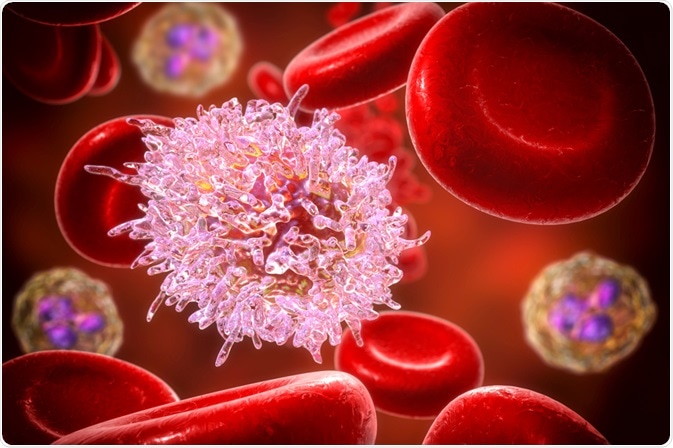Down syndrome, also known as trisomy 21, is a condition where there are three copies of chromosome 21, rather than two. Those with Down syndrome have a 20 to 500-times higher risk of developing leukemia.

Image Credit: Kateryna Kon/Shutterstock.com
Children and leukemia
Down syndrome affects between 1 in 700 and 1 in 1000 newborns. Acute megakaryoblastic leukemia, which is otherwise quite rare, is 500-times more likely in children with Down syndrome, whereas acute lymphoblastic leukemia is 20-times more likely. Despite this, children with Down syndrome have a lower risk of solid tumor development.
Acute megakaryoblastic leukemia tends to affect younger children below the age of 4, whereas acute lymphoblastic leukemia occurs in older children. Most cases of acute megakaryoblastic leukemia occur between 1 and 2 years old.
At least half of all cases of leukemia in Down syndrome affected children appear to be due to acute megakaryoblastic leukemia.
Some evidence suggests that the production of blood cell types and platelets, also known as hematopoiesis, is abnormal in children with Down syndrome. This can result in a higher volume of red blood cells, thus highlighting the conflicting nature of the trisomy 21 state and the effect this has on the blood and immune system.
Acute megakaryoblastic leukemia
Individuals with Down syndrome have a high occurrence of erythroleukaemia, and many of these cells have properties of megakaryoblasts. It would, therefore, appear that most cases of acute megakaryoblastic leukemia in Down syndrome individuals comes from the proliferation of a hematopoietic progenitor cell that can become both megakaryocytes and erythroid precursor cells.
Acute megakaryoblastic leukemia is always seen with mutations in the GATA1 gene, which encodes a regulator of erythromegakaryocytic formation. The mutations occur in the womb, probably alongside other genetic events that are likely needed to develop leukemia.
Epigenetics studies have identified one Down syndrome-specific wave where there is a loss of DNA methylation, followed by a leukemia-specific wave of hypermethylation. Whereas the first wave targets genes associated with developmental disorders, the second wave targets genes associated with hematopoiesis and cell growth regulation.
This may help explain why children with Down syndrome higher occurrence of acute megakaryoblastic leukemia have since both waves of epigenetic changes are distinctly different from those of children without Down syndrome.
Acute lymphoblastic leukemia
Acute lymphoblastic leukemia occurs when lymphoblasts, derived from lymphoid stem cells, become cancerous. The affected cells are usually B-lymphocytes and T-lymphocytes in pediatric cases.
In addition to the increased occurrence, children with Down syndrome children and acute lymphoblastic leukemia have a lower overall survival rate than children without Down syndrome (70% versus 80%).
The progression is associated with mutations in JAK2, CRLF2, NOTCH1, and occasionally PRAME. Mutations in JAK2 are found in 20% of Down syndrome lymphoblastic leukemia cases and CRLF2 mutations in 60% of patients. Patients who also have mutations in the RAS gene make up roughly 1/3 of those with Down syndrome acute lymphoblastic leukemia.
Therapies and challenges
Because there are many types of leukemia and many possible confounding factors when it co-occurs with Down syndrome, it can be difficult to treat effectively. Many patients who receive treatment for leukemia will relapse.
Some solutions suggest targeting pre-leukemic cells and killing off leukemic stem cells, but even identification of these cells can be hard. Furthermore, in some patients with Down syndrome, acute megakaryoblastic leukemia, and acute lymphoblastic leukemia occur simultaneously.
Generally, epigenetics is seen as the future of both the study and the solution of Down syndrome-associated leukemia. However, it is unknown whether changes in epigenetic patterns are contributors to the disease or if they are indications of the underlying genetic lesions.
Sources
- Malinge S. et al. (2013) Development of acute megakaryoblastic leukaemia in Down syndrome is associated with sequential epigenetic changes. Blood. https://doi.org/10.1182/blood-2013-05-503011
- Mateos, M.K. et al. (2015) Down syndrome and leukemia: insights into leukemogenesis and translational targets. Translation Pediatrics. https://doi.org/10.3978/j.issn.2224-4336.2015.03.03
- Zipursky, A., Poon, A., and Doyle, J. (1992) Leukemia in Down syndrome: a review. Pediatric hematology and oncology. https://doi.org/10.3109/08880019209018329
Further Reading
Last Updated: Mar 30, 2020